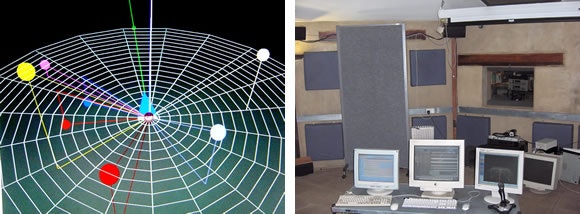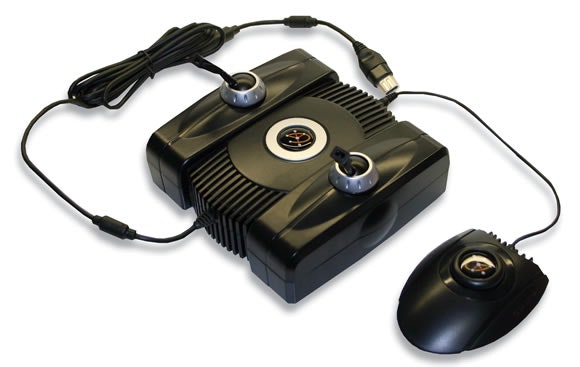Drop Spin Fade
Drop Spin Fade is an experiment in spatial soundscapes using game technology. A collaboration between Chris O’Shea and Owen Lloyd.
May 2007
Introduction

A collaboration with sound artist Owen Lloyd. We were invited to take part in the Future of Sound tour, showcasing the 3d sound imaging system made by Martyn Ware’s company Illustrious. This system takes up to 16 audio inputs and positional data, enabling artists & composers to create soundscapes over a multi-layered speaker array (shown above).
Our aim was to work on an interactive soundscape system, and to present our work so far on each stage of the tour. The virtual space that would represent the physical audio space, using gestural video game technology as input. We wanted to create a playful and game-like experience, with no goals or objectives. We began to play with the metaphor of the hands, what possibilities are there if you could sculpt, stretch, push and spin sounds.
Input

Gametrak is a controller from In2Games that accurately tracks the position of your hands. The benefits are that it is low cost and low latency. By reading the HID data, then calculating the angles and distances, it is possible to use this hand tracking device outside of the games it was intended for.
Prototype1
This version was shown at FACT in Liverpool and at the Millennium Galleries in Sheffield. It was the initial prototype to get sounds moving around a 3D space with the Illustrious system and sound wise, the functionality was quite basic.
In this version the user could you their hands to push simple primitive geometric objects around a virtual 3D space. These objects had predefined linear sound loops attached, thereby providing spatial positioning for the sounds over 16 channels. The cubed space represents the speaker space, with the listener standing in the centre. The hand graphic gets a darker surround as you get near to the sound object, an attempt at visual feedback where tactile does not exist. By bringing your hands together it clears the scene.
Prototype 2
This version was shown at Goldsmiths College in London and was a more involved prototype using a granular playback engine for the sound. The granular engine allows more interaction with the sound and a direct connection between sound and object visuals. Instead of primitive shapes, the mesh shapes were modulated by the amplitude of the sounds they contained.
The rate of rotation of each object now controls the rate of playback for the sound contained, this applies bi-directionally, with reverse spin scrubbing through the sound backwards. The size of the object is also changeable and relates to pitch, large objects are pitched low and small pitched high.
There is also a degradation system affected by object collisions whereby sounds can collide a number of times with walls or other objects before they disappear. As they collide the sounds degrade in terms of their granular playback with each collision affecting their grain size, density and smear. There is also a synthesized collision sound, used sparsely, to underline this event from time to time.
Technical details
The visuals and interactive system were programmed in Lingo using Adobe Director. The sound engine is programmed in Max/MSP. Communication between the two was via Open Sound Control, and position data sent to Illustrious via MIDI. Programming of Gametrak input was using the Joystick Xtra for Director.









